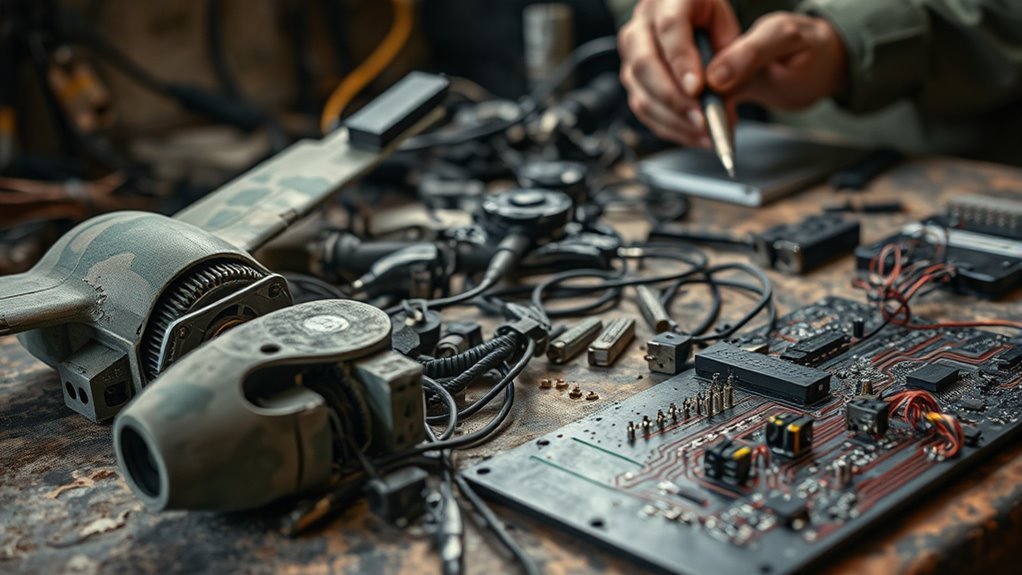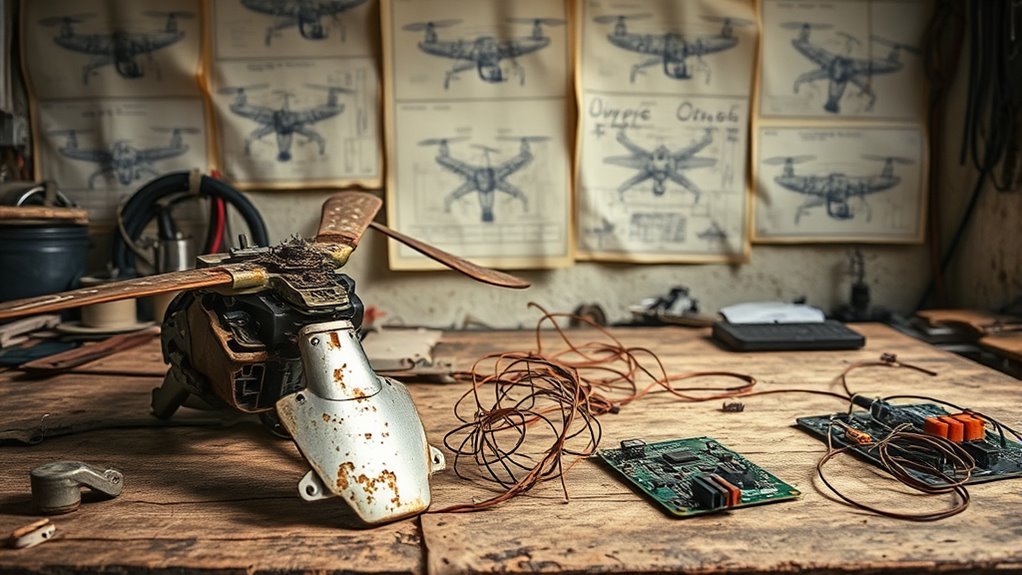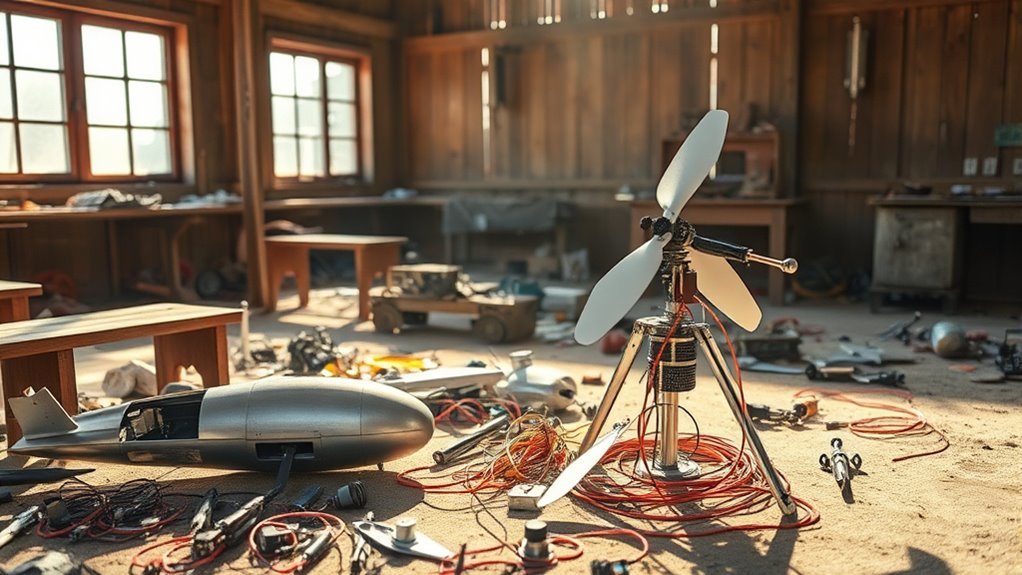To effectively use drone parts from the last war, assess each component for application in surveillance, robotics, or artistic projects. Prioritize safety by employing personal protective equipment and conducting risk assessments. Guarantee compliance with legal standards and ethical guidelines when utilizing military technology. Tools like soldering irons and multimeters are essential for integration. Consider how each part enhances operational effectiveness in your project. Further exploration of these strategies will offer deeper insight into successful repurposing techniques.
Understanding the Components of Military Drones

Military drones are complex systems comprised of various components, each playing a critical role in their overall functionality. Understanding these components is essential for maximizing their effectiveness. At the heart of these systems are drone propulsion systems, which provide the necessary thrust for maneuverability and endurance. These systems are intricately designed to optimize fuel efficiency while maintaining speed and agility. Coupled with advanced aerial surveillance technology, drones can gather real-time intelligence, allowing operators to make informed decisions. The combination of propulsion and surveillance capabilities not only enhances operational effectiveness but also supports strategic objectives. As you explore these components, it becomes clear that effective utilization hinges on a thorough understanding of their interdependent roles within military applications.
Safety Considerations When Handling Drone Parts

Handling drone parts requires a keen awareness of safety protocols, particularly given the complexity and precision engineering involved in military applications. To guarantee your safety and the functionality of the components, you should conduct a thorough risk assessment and always use personal protective equipment (PPE). Here are essential safety considerations:
Handling drone parts necessitates strict adherence to safety protocols to ensure both personal safety and the integrity of complex military components.
- Wear gloves to prevent cuts and chemical exposure.
- Use safety goggles to protect your eyes from debris.
- Ensure proper ventilation when working with electronic components.
- Be aware of sharp edges on metal parts.
- Keep a fire extinguisher nearby when handling batteries.
Creative Project Ideas Using Drone Parts

Using drone parts creatively can transform discarded components into functional and artistic innovations. You can explore projects like upcycled drone art, which not only showcases your creativity but also minimizes waste. Additionally, consider crafting functional garden decor or even innovative tech gadgets that enhance daily life, all while leveraging the unique capabilities of drone technology.
Upcycled Drone Art
Upcycling drone parts into art can yield a multitude of creative possibilities, transforming discarded components into unique, functional pieces. By reimagining these materials, you’re not only making a statement but also embracing sustainability. Here are some strategic project ideas:
- Upcycled sculptures: Create eye-catching installations that challenge perceptions of waste.
- Drone photography displays: Use parts to frame or showcase aerial images, merging technology and art.
- Functional furniture: Design tables or chairs utilizing drone frames for an industrial look.
- Wall art: Assemble components into abstract pieces that tell a story.
- Lighting fixtures: Convert motors and lights into striking lamps that illuminate your space.
Engaging in these projects allows you to express creativity while advocating for environmental consciousness.
Functional Garden Decor
Transforming drone parts into functional garden decor can enhance both the aesthetics and utility of your outdoor space. By utilizing drone frames and propellers, you can create innovative drone planters that not only serve as unique planting vessels but also add a modern touch to your garden. Consider repurposing motors and cameras for aerial sculptures that capture attention and provoke thought. Strategically positioning these sculptures can create visual focal points or even serve as wind chimes, harnessing the breeze to generate sound. Such projects allow you to express creativity while promoting sustainability. Ultimately, these functional decor items embody freedom—freedom to innovate, create, and redefine your garden using materials that would otherwise go to waste.
Innovative Tech Gadgets
While many people view drone parts as mere remnants of obsolete technology, they can actually be repurposed into innovative tech gadgets that enhance everyday functionality. By harnessing drone technology, you can create gadget innovations that serve practical purposes. Here are five project ideas to take into account:
- Smart Home Surveillance: Use cameras and sensors for enhanced home security.
- Portable Power Bank: Repurpose battery packs for on-the-go charging.
- Remote-Controlled Vehicles: Combine motors and frames for custom RC cars or boats.
- Autonomous Plant Waterer: Use sensors and pumps to automate your garden irrigation.
- DIY Drone: Assemble leftover parts into a new flying drone for personal use.
Each project not only gives new life to old components but fosters a spirit of creativity and independence.
Essential Tools for Repurposing Drone Components
To effectively repurpose drone components, you’ll need a set of essential tools that facilitate both repair and modification. Start by assembling necessary repair equipment like soldering irons and multi-tools, which are critical for handling intricate electronic parts. Don’t overlook safety gear; ensuring protection while working with these components is paramount to avoid injuries.
Necessary Repair Equipment
When you’re ready to repurpose drone components, having the right repair equipment is essential to ensuring a successful process. Effective equipment sourcing can enhance your repair techniques, allowing you to transform these parts into functional tools. Here are five must-have items:
- Soldering Iron: For precise electrical connections.
- Multimeter: To test voltage and diagnose issues.
- Precision Screwdriver Set: Essential for disassembling components without damage.
- Wire Strippers: For working with electrical wiring efficiently.
- Hot Glue Gun: Ideal for quick fixes and securing loose components.
Equipping yourself with these tools not only streamlines the repair process but also empowers you to creatively innovate with drone parts. Embrace the freedom to create and repurpose effectively.
Safety Gear Essentials
Safety gear is an essential component of repurposing drone parts, ensuring you stay protected during the repair process. First, invest in high-quality gloves; they’ll protect your hands from sharp edges and electrical components. Next, safety goggles are a must, as they shield your eyes from debris and dust. Don’t overlook a durable face mask; it’ll help filter out harmful particles that can be released while working. Additionally, consider an anti-static wrist strap to prevent damage to sensitive electronics. Finally, wear a sturdy apron to protect your clothing and keep tools easily accessible. By equipping yourself with proper protective equipment, you enhance both your safety and efficiency, allowing you to focus on the creative aspects of repurposing drone components.
Legal and Ethical Considerations in Using Military Technology
While the allure of military technology, such as drones, can be compelling for various applications, it is vital to navigate the complex landscape of legal and ethical considerations. Understanding military regulations and the ethical implications of using these technologies is important for avoiding legal pitfalls and maintaining integrity.
- Assess the legality of using former military equipment.
- Guarantee compliance with local and international laws.
- Consider the ethical ramifications of surveillance and privacy.
- Evaluate the potential impact on community safety and trust.
- Stay informed about evolving regulations and public sentiment.
Tips for Integrating Drone Parts Into Your Projects
Maneuvering through the legal and ethical landscape surrounding military technology is just the beginning; integrating drone parts into your projects requires a strategic approach to maximize functionality while minimizing risks. Start with a thorough assessment of the components you have, focusing on their potential applications in your designs. Consider the following table as a guide for effective integration:
| Component | Application | Considerations |
|---|---|---|
| Flight Controller | Autonomous systems | Verify compatibility |
| Motors | Robotics/vehicles | Check power requirements |
| Cameras | Surveillance/monitoring | Evaluate resolution |
Additionally, understanding NDAA compliance is crucial when sourcing components to ensure you are adhering to regulatory standards. Incorporating advanced safety mechanisms can also enhance the reliability of your projects while utilizing military drone parts.
Frequently Asked Questions
Can I Sell Repurposed Drone Parts Commercially?
You can sell repurposed drone parts commercially, but you need to take into account legal considerations like regulations and licensing. It’s essential to guarantee compliance to avoid potential legal issues while maximizing your freedom in the market.
How Do I Find Military Drone Parts Legally?
Maneuvering through the labyrinth of military regulations, you’ll need to adhere to strict sourcing guidelines. Research authorized dealers, attend surplus auctions, or connect with veterans to legally acquire military drone parts while ensuring compliance with all applicable laws.
What Are the Risks of Using Outdated Drone Technology?
Using outdated drone technology poses safety concerns and significant technological limitations. You risk operational failures, vulnerabilities to modern countermeasures, and potential legal repercussions, which could undermine your strategic objectives and jeopardize your pursuit of freedom.
Can I Use Parts From Different Drone Models Together?
You can use parts from different drone models, but be cautious of intercompatibility issues and performance variations. Analyzing compatibility can help maximize efficiency, ensuring your modifications align with strategic objectives without compromising overall functionality.
What Certifications Do I Need for Drone Component Projects?
When undertaking drone component projects, you’ll need to understand certification requirements and project regulations. Familiarize yourself with local laws, as compliance guarantees safety while allowing you the freedom to innovate effectively and responsibly.

